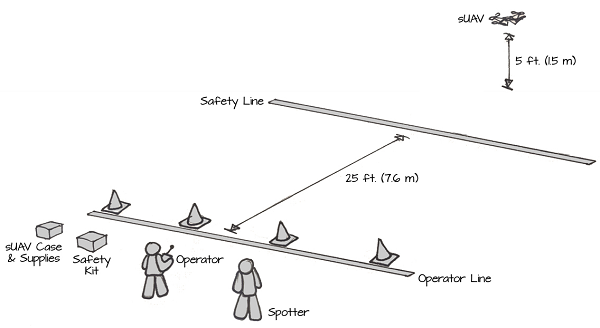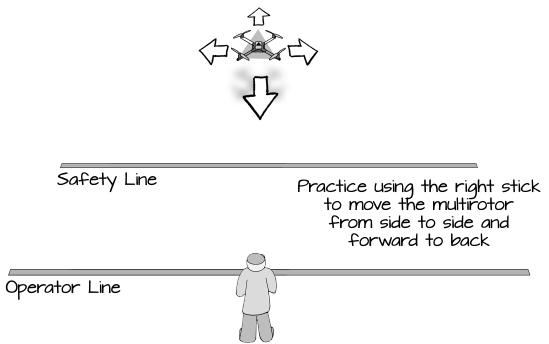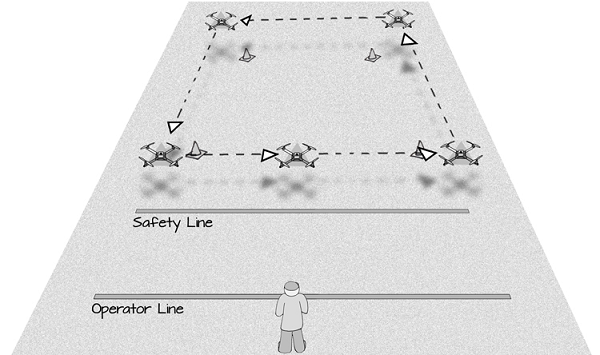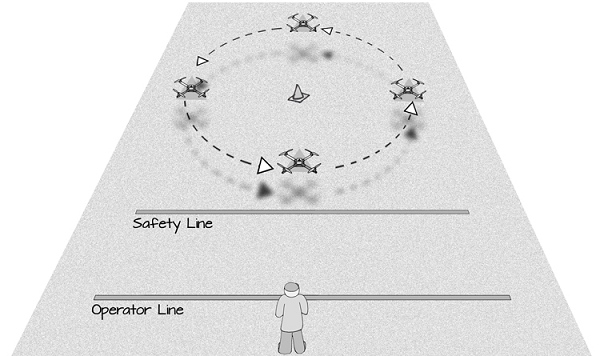Beginner (Low-Risk) Flight Practice
Before you go out and fly your full-size multirotor, it would be prudent to spend some time practicing operating RC multirotors in a low-risk fashion, where dozens of crashes won’t stretch your wallet thin.
There are two main ways to practice flying:
- We strongly recommend you purchase a BNF (bind-‘n-fly) Mini Quadcopter. BNF will allow you to use your transmitter (the same one you will use for the ELEV-8). These inexpensive and nearly indestructible models are designed for indoor flight and are a great way to learn how to fly using your particular transmitter without worrying about damage from crashing.
- Flight Simulators are another potential option for learning how to fly RC model aircraft. They are usually computer programs that come with an adapter that allow you to connect your transmitter to your computer.
First Full-Scale Flights
Once you are comfortable with your flying abilities, you can at last begin flying your full-size multirotor! What follows is some general advice on how to successfully approach your first few flights. The first thing any new operator must learn is throttle control. Below are some steps we recommend following to help you get a handle on the matter. (Don’t forget about all of the guidelines, warnings, and precautions!). Keep in mind that learning this will take dozens of flights. It is not something you can learn in a day, or even a week, and complete mastery will take many months of dedicated practice.
Place the multirotor on the ground facing away from you in a wide open area. Plug in the battery. Step back at least 25 ft. You and your spotter should be wearing safety eyewear:

Hovering
After arming the flight controller, slowly and carefully increase the throttle until the multirotor begins to lift off. For most multirotors, it takes approximately 50% throttle to take off. As soon as your multirotor leaves the ground, gently ease off and begin to decrease the throttle and land.
If all systems are working correctly, the multirotor should not drift much horizontally and it should maintain fairly level flight. If this is not the case, then stop and troubleshoot; an sUAV can’t be flown safely with faulty hardware or software.
If the quadcopter simply flipped over and pancaked, go back and check your propellers - they may have been mounted in the wrong direction.
Repeat this process, gently lift off and then land again, until you have a good feel for how much throttle is required to keep the quad in the air. Try keeping it airborne slightly longer - but don't worry about sideways drift yet, all we care about right now is that the quad stays at a steady height. For now, keep the multirotor below head height at all times. If the quad drifts too far, ease off the throttle and land it.
Once you are able to hold the multirotor at a steady altitude, try to use the right (roll/pitch) stick to counteract the multirotor's horizontal drift. If the multirotor drifts left, move the stick to the right just slightly. If it starts drifting towards you, push the stick up a fraction. You want to get a feel for how the multirotor moves and responds to control. At this point, holding your multirotor at a steady height should be mostly automatic. Remember to cut the throttle if the multirotor gets out of position, and especially if it starts moving towards you.
Continue to practice this until you can hover the multirotor in one spot for a full battery pack. At that point, you're ready to move on.
Flying Side-to-Side and Front-to-Back
With the nose of the multirotor pointed away from you, gently take off and hover your multirotor approximately 5 ft (1.5 m) off of the ground. Gently push the right stick left and then right. The multirotor will move in the same direction as your pushes on the right stick. Repeat this process by pushing the right stick up and down instead of side to side. This will help you get a feel for how to respond to the momentum of your sUAV in flight. Make sure to maintain at least 25 ft. (7.6 m) between you and your multirotor, and cut the throttle if it gets too close:

Next, after moving your quadcopter to different locations, practice landing your multirotor in a small area, such as within a few feet of a marker on the field. Make sure that you are not flying too close to any lightweight objects such as leaves that could be blown into your sUAV’s propellers.
Once you are able to move your quadcopter and land it a specific spot, set up a course like the one shown below to practice following a specific path. Begin with a square, flying in straight lines to reach each point:

As you become more comfortable navigating a course with your multirotor, try flying it in a circle. This will allow you to practice controlling both the Ailerons and Elevator (right stick controls) at the same time:

